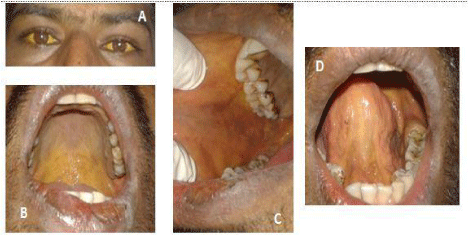
Clinical Image
Austin J Dent. 2017; 4(2): 1066.
Oral Manifestations in Chronic Liver Failure
Suvarna R*, Rao PK, Kini R, Bandarkar GP and Kashyap RR
Department of Oral Medicine and Radiology, AJ Institute of Dental Sciences, India
*Corresponding author: Reshma Suvarna, Department of Oral Medicine and Radiology, AJ Institute of Dental Sciences, Kuntikana, NH-66, Mangaluru, Karnataka, India
Received: January 24, 2017; Accepted: February 06, 2017; Published: February 10, 2017
Clinical Image
A 31 year old male patient came with the chief complaint of deposits and stains on the tooth surface since 3 years. He is a known case of chronic liver failure since 8 years and is under medication since then. His dental and family history was non-contibutory. He consumes alcohol since ten years. On extra-oral examination, icterus was noticed on both the eyes (Figure 1A). Intra-oral examination revealed yellowish discoloration of the oral mucosa involving the right and left buccal mucosa, ventral aspect of the tongue, palate, upper and lower labial mucosa (Figure 1B,C and D). Mild Supragingival calculus and stains were present. Dentinal caries was seen in relation to maxillary left molars, mandibular right and left molars.

Figure 1: Icterus noticed on the sclera of both the eyes. B, C and D:
Yellowish discoloration of the oral mucosa involving the buccal mucosa,
ventral aspect of the tongue, and palate.
Cirrhosis is a complication of chronic liver failure, and jaundice is common observation in cirrhosis. The word jaundice is from the French word jaunisse, meaning “yellow disease”. It is yellowish pigmentation of the skin and sclera due to high bilirubin levels [1]. Levels of bilirubin in blood are normally below 1.0 mg/dL (17 μmol/L) and levels over 2-3 mg/dL (34-51 μmol/L) typically results in jaundice. High bilirubin is divided into two types: unconjugated (indirect) and conjugated (direct). Conditions like carotenemia and medications like rifampin can cause yellowish pigmentation of the skin [2].
Jaundice is characterized by an excess of bilirubin in plasma and its accumulation within the tissues, resulting in a uniform, diffuse yellowish colour of the skin, mucosa and the sclera of the eye. The intensity of the yellow coloration varies with the bilirubin serum level [3]. The conjunctiva of the eye are one of the first tissues to change color as bilirubin levels rise in jaundice, as they have affinity for bilirubin due to their high elastin content. This is sometimes referred to as scleral icterus. In the oral mucosa, the discolouration is more frequently found at the junction between hard and soft palate, ventral surface of the tongue and cheeks, due to the affinity of the elastic fibres for bilirubin. Hepatocellular jaundice usually causes cirrhosis, where cell necrosis reduces the liver’s ability to metabolize and excrete bilirubin leading to a buildup of unconjugated bilirubin in the blood. Treatment of jaundice is typically determined by the underlying cause [4].
References
- Mahan TB, Joann T, Patricia PB, Joanne SC. Primary Care: A Collaborative Practice. Elsevier Health Sciences. 2012; 4: 690.
- Oroll, Allan H. Primary care medicine :office evaluation and management of the adult patient. Philadelphia: Wolters Kluwer Health/Lippincott Williams & Wilkins. 2006; 6: 496.
- Gomez I, Varela P, Romero A, García MJ, Suárez MM, Seoane J, et al. Yellowish lesions of the oral cavity. Suggestion for a classification. Med Oral Pathol Oral Cir Bucal. 2007; 12: E272-276.
- Collier J, Longore M, Turmezei T, Mafi AR. “Neonatal jaundice”. Oxford Handbook of Clinical Specialties. Oxford University Press 2010.